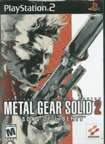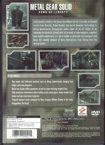Most franchise sequels obey their particular Series Maps. From a business perspective, sequels resemble ancient fertility rituals: the dead hit returns in new digital sheaves, and cash will rain for another year. The market conspires with corporate interests, and players expect loyalty to the annual rites.
MGS2 players knew that they would play the sequel to Metal Gear
Solid, the Jesus Christ Superstar of the first Playstation console.
MGS2 twisted the ritual when it knew that the player knew that MGS2 was the sequel to MGS1. It knew that the player expected to control the superspy Solid Snake; discover and destroy the perennial doomsday machine, Metal Gear; unearth and resolve conspiracies; redeem Solid Snake from his accidental implication in said conspiracies; fight terrorists led by elite supersoldiers; and avoid detection in order to complete his Player Objectives.
The Tanker Chapter comprised the first two hours of MGS2. Solid Snake covertly investigated a dummy oil tanker that housed the latest incarnation of Metal Gear, a classified nuclear tank, and terrorists took control of the ship. Snake himself narrated the opening in tones of dejected hindsight, dramatically recalling when he had failed, redeemed himself, and persevered in MGS1.


|
The map crinkled in our hands.